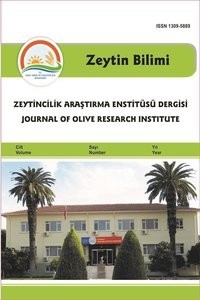Farklı Bileşimlerde Bor, Azot ve Potasyumlu Yaprak Gübrelerinin Domat Zeytin Çeşidinde Çiçek Tozu Canlılığı, Çimlenmesi ve Meyve Tutumu Üzerine Etkileri
Meyve tutumu, meyve üretiminde en önemli aşamalardan biridir. Bu süreçte çiçek tozlarının canlılığı ve çimlenmesi önem taşımaktadır. Yaprak besin elementi uygulamaları çiçek tozu canlılığı, çimlenmesi ve meyve tutumunda etkili olmaktadır. Bu noktadan hareketle, Domat zeytin çeşidinde iki yıl yürütülen çalışmada, biri borik asit, diğeri de sıvı olmak üzere, iki farklı borlu gübre, üre ve potasyum nitrat (KNO3) ile farklı birleşimlerde yapraktan uygulanmış, çiçek tozu canlılığı, çimlenmesi ve meyve tutumuna etkileri araştırılmıştır Çiçek tozu canlılık oranı bakımından dolu ürün yılında, sadece “sıvı bor + üre + KNO3” uygulaması en yüksek değer verirken, boş ürün yılında tüm uygulamalarda kontrol grubuna göre yüksek değerler tespit edilmiştir. Her iki yılda da çiçek tozu çimlenme gücü bakımından en yüksek değerler aynı uygulama ile elde edilmiştir. Meyve tutumu üzerinde genellikle üre ve borik asit ya da borlu sıvı gübrenin tekli uygulaması etkili bulunmuştur. Ayrıca “sıvı bor + üre + KNO3” uygulamasında boş ürün yılında meyve tutumu da kontrole nazaran yüksek bulunmuştur. Diğer yandan, boş ürün yılında, genellikle uygulamaların kontrole göre her üç parametre üzerinde olumlu etki gösterdiği belirlenmiştir.
The Effect of Foliar Application Boron, Nitrogen and Potassium at Different Combinations on Pollen Viability, Germination and Fruit Set in Domat Olive Cultivar
Fruit set is one of the most important stages in fruit production. The viability and germination of pollen are of great importance at this development. Leaf nutrient treatments effect on viability and germination of pollen and fruit set. Taking into account this situation, in the current study, the effects of different leaf applications combinations of boron as liquid and solid forms with urea and KNO3 were investigated on the viability and germination of pollen and fruit set on Domat olive cultivar during two years. The highest pollen viability was obtained only in the “liquid boron fertilizer + urea + KNO3” application in the on year, whereas all applications had the highest value than the control in the off year. The highest pollen germination was determined in the same application for two years. Single applications of urea, boric acid and liquid boron fertilizers were found to be effective on fruit set, in general. Additionally, the same application was over the control in the off year in terms of fruit set. On the other hand, it was stated that all of the applications affected positively investigated parameters comparing to the control in the off year
- ISSN: 1309-5889
- Başlangıç: 2010
- Yayıncı: Zeytincilik Araştırma Enstitüsü Müdürlüğü - İZMİR
